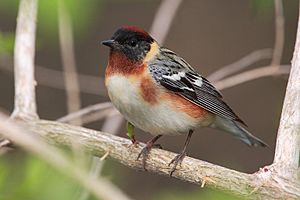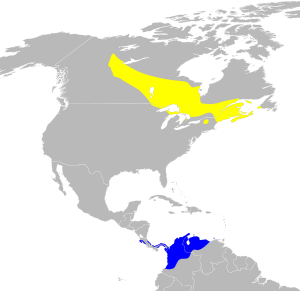Bay-breasted warbler facts for kids
Quick facts for kids Bay-breasted warbler |
|
|---|---|
 |
|
| Conservation status | |
| Scientific classification | |
| Genus: |
Setophaga
|
| Species: |
castanea
|
 |
|
| Range of S. castanea Breeding range Wintering range | |
| Synonyms | |
|
Dendroica castanea |
|
The Bay-breasted Warbler (Setophaga castanea) is a small, colorful songbird. It belongs to a group of birds called New World warblers. This bird is part of a large family of songbirds known as Setophaga. Like all songbirds, it's a type of passerine bird.
Contents
Where Do Bay-breasted Warblers Live?
Bay-breasted Warblers spend their summers in the cool, northern forests. They live in spruce and fir trees across eastern and central Canada. You can also find them in the far northern United States.
When winter comes, these birds fly south. They travel to warm, wet forests in northeastern South America and southern Central America. During spring and fall, you might spot them in the eastern United States. They fly over the Gulf of Mexico on their long journey. Some also travel along the coast of Mexico.
What Do Bay-breasted Warblers Eat?
During the summer, Bay-breasted Warblers mostly eat insects and spiders. They especially love the spruce budworm. They pick these tiny creatures off plants and trees. They do not catch insects while flying.
To avoid competing with other birds, they look for food in the middle parts of evergreen trees. In winter, when they are in warmer places, they eat a lot of fruit. These warblers often join groups of different bird species. They search for food together high up in the trees. Bay-breasted Warblers can be quite bold. They sometimes push smaller birds away from food!
Nesting Habits
Bay-breasted Warblers usually build their nests in the lower branches of spruce or fir trees. Their nests are shaped like a cup. They are made mostly from plant materials. The birds often use spider silk to help hold the nest together.
A female warbler usually lays 4 to 7 eggs. The eggs are whitish with dark spots. When the baby birds hatch, they are very helpless. They have only a little bit of soft downy feathers.
What Do Bay-breasted Warblers Look Like?
Male Bay-breasted Warblers in summer are mostly grayish on their backs. They have two white bars on their wings. Their backs also have dark streaks. A creamy patch is found on their neck. Their face is black, and their crown, throat, and sides are a dark chestnut color.
Female Bay-breasted Warblers in summer look similar to males. However, their colors are lighter and not as bright. In other seasons, both male and female birds get olive-green feathers. These new feathers appear on their back, neck, and head. The chestnut color on their sides becomes less noticeable. In nonbreeding females, it might even disappear. The two white wing bars are always present, no matter the season.
Similar Birds
Sometimes, the Bay-breasted Warbler can be confused with other birds.
- The Chestnut-sided Warbler (Setophaga pensylvanica) has similar chestnut colors on its sides. But its chestnut color does not reach its throat or crown. Chestnut-sided Warblers also have a bright yellow crown, a dark mask, and white cheeks and throat in summer.
- In the fall, nonbreeding Bay-breasted Warblers might look like Blackpoll Warblers (Setophaga striata). However, Blackpoll Warblers never have any chestnut color on their sides. They also have yellowish feet, while Bay-breasted Warblers have black feet.
Conservation
Bay-breasted Warblers are currently listed as "Least Concern" by conservation groups. This means they are not in immediate danger of disappearing. However, like many songbirds, their numbers are decreasing. Losing their insect food and changes in global climate are reasons for this decline. It is estimated that fewer than 10 million of these birds are left in the world.
Images for kids
-
Male in Quintana, Texas
-
Nonbreeding adult in New York City
See also
 In Spanish: Reinita castaña para niños
In Spanish: Reinita castaña para niños






